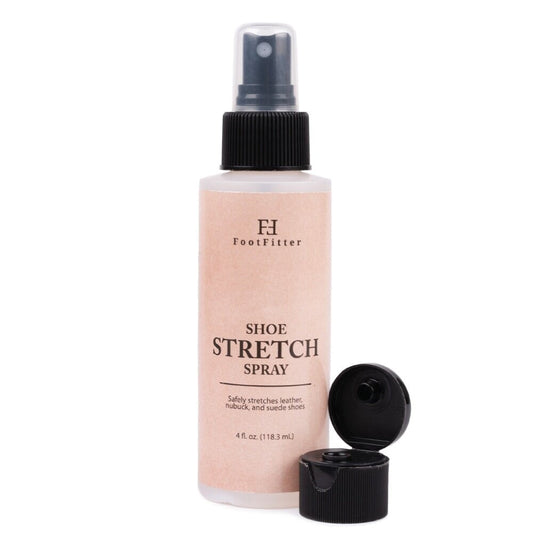
5 Common Problems with Heels and How You Can Avoid Them
Share
Heels add a classy, feminine touch to any outfit. Not to mention, they elongate your legs by adding a few extra inches. However, despite all the beauty they bring, heels can also cause foot pain and are prone to damage. Fortunately, with the right insight, you can eliminate the common problems with heels that many experience.
In fact, your heels can be something you may have never expected: cute and comfortable.
From being hard to walk in to causing blisters, FootFitter breaks down five common problems with heels. Keep reading to find the perfect solution for each issue.
Problems with heels #1: hard to walk in
It’s the most common problem women face when it comes to high heels: they aren’t very easy to walk in.
Whether heels aren’t something you wear very often or you’re pulling an exceptionally sky-high pair from your closet for a special event, no one wants to strut around with the gracefulness of a newborn deer.
Understandably, choosing wedges over stilettos makes walking more effortless because your weight is spread out evenly instead of concentrated to a thin point.
However, some outfits call for the spikier alternative.
Unfortunately, thin heels easily get trapped in sidewalk cracks, slide on smooth surfaces and wobble on brick and asphalt walkways.

To fix the instability problem, throw on a pair of heel caps.
Heel caps offer more grip to the bottom of your stilettos by providing a small rubber layer.
In addition to keeping your legs from wobbling, heel caps protect your stilettos from getting stuck or damaged on rough, uneven terrains.
Also great for the office or an event with hard floors, heel caps help to dampen the clicking sound when you walk.
Problems with heels #2: unstable heel straps
Strapped heels look great with jeans. However, one-size straps don’t always fit all.
Your shoes may be in the right size for your feet but if the straps are too big it can throw off your intended look.
Suffering through too-tight heels in an attempt to find tighter straps shouldn’t be the option you choose.

After all, forcing your feet into heels that are too tight can cause a variety of health issues from blisters to bunions.
Heel sling adhesives offer a compromise.
The thin sticky layer locks slippery straps firmly against your ankles or feet.
WEARING NEW HEELS
Problems with heels #3: chaffed heels
Unfortunately, cracked heels are a common problem, especially among women. One of the major contributors to cracking skin is chaffing.
Chaffing occurs when your shoe backing rubs too hard against your skin, creating dryness and blisters. This typically comes from new shoes that are stiff or in a size too small.
However, you can’t always rule your old heels out as the chaffing culprit because extra walking can also cause burns, cuts or a scaly texture.

To counteract chaffing, make sure to stay hydrated and pick up a daily moisturizer that you can use on your feet once or twice a day.
In the meantime, keeping your heels comfortable is still possible. Adding socks to your look or sliding in heel grips will add a protective layer between your shoe and skin. This ensures you keep up your style without bringing along any discomfort.
Problems with heels #4: blistered toes
In other common cases, blisters appear on your toes at the front of your shoe instead of the back. Unfortunately, if your toes are taking the brunt of the blisters instead of your heels, extra ankle padding won’t give you much relief.
Oftentimes, blisters in the toe box area are a result of bad sizing. Whether you’re squeezing your toes into a size too small or giving them too much wiggle room, shoes that don’t stay in their proper place often attack your toes.

On the other hand, certain styles and materials run snug at first but can naturally stretch out over time or ease with the help of a tool. For example, leather loosens its stiffness with wear.
However, using a shoe stretcher allows you to break your shoes in without the need for wear and the possibility of blisters.
In addition, choosing styles like platform heels or wedges help to level out your feet. This creates less of a downward slope that puts pressure on your toes.
Problems with heels #5: scuffs and stains
The final common problem is one that can easily get under your skin. You know the scenario, you bought the perfect pair of heels for an event and sadly they double as a napkin for a spilled drink or get scuffed on the dance floor.

Dealing with dirty heels is something every woman must face. However, you don’t have to solve the issue by ditching your heels and heading back to the shoe store every time they get a little roughed up.
Understanding your shoe’s material solves half the problem. If you have scuffs or stains on your suede pair, reaching for a suede or nubuck cleaner will help you quickly buff imperfections away. Likewise, leather heels lacking luster call for a reliable polish to restore their original sheen.
All in all, heels cause common problems for a lot of us. However, with a little extra planning and a little help from the tips listed above, beauty doesn’t have to mean pain.
Main image by Jose Musa via Pexels










